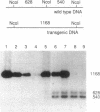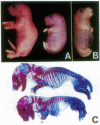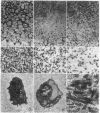Abstract
We have generated transgenic mice harboring a glycine-to-cysteine mutation in residue 85 of the triple helical domain of mouse type II collagen. The offspring of different founders displayed a phenotype of severe chondrodysplasia characterized by short limbs and trunk, cranio-facial deformities, and cleft palate. The affected pups died of acute respiratory distress caused by an inability to inflate lungs at birth. Staining of the skeleton showed a severe retardation of growth for practically all bones. Light microscopic examination indicated a decrease in cartilage matrix density, a severe disorganization of growth plate architecture, and the presence of streaks of fibrillar material in the cartilage matrix. Electron microscopic analysis showed a pronounced decrease in the number of typical thin cartilage collagen fibrils, distension of the rough endoplasmic reticulum of chondrocytes, and the presence of abnormally large banded collagen fibril bundles. The level of expression of the mutant type II procollagen alpha 1 chain transgene in cartilage tissues was approximately equal to that of the endogenous gene in two of the strains. We propose that the principal consequence of the mutation is a considerable reduction in density of the typical thin cartilage collagen fibrils and that this phenomenon causes the severe disorganization of the growth plate. We also postulate that the abnormal thick collagen fibrils are probably related to a defect in crosslinking between the collagen molecules. The cartilage anomalies displayed by these transgenic mice are remarkably similar to those of certain human chondrodysplasias.
Full text
PDF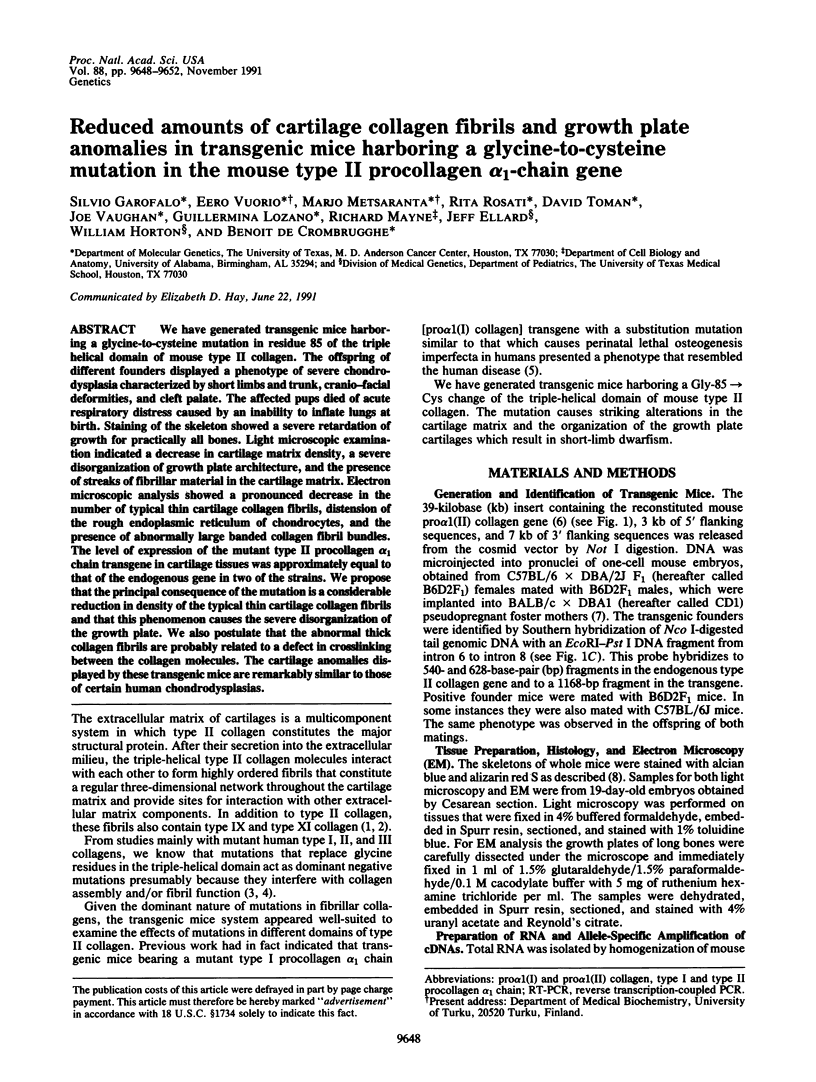
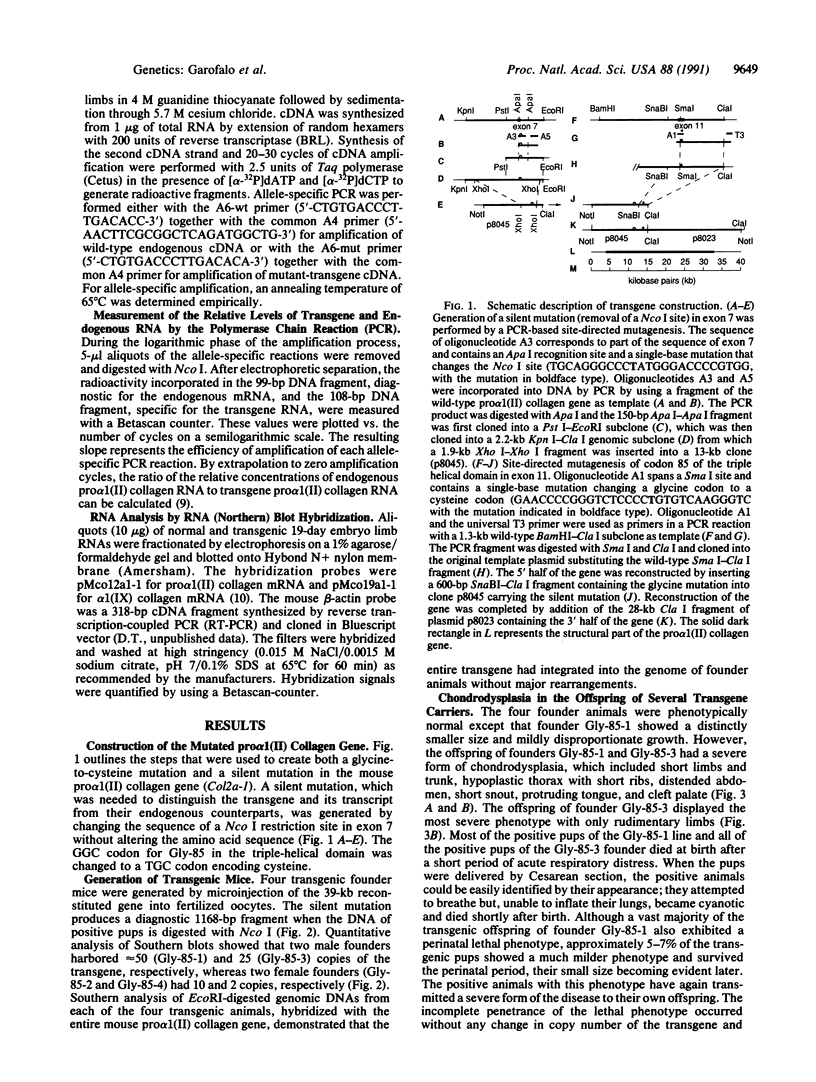
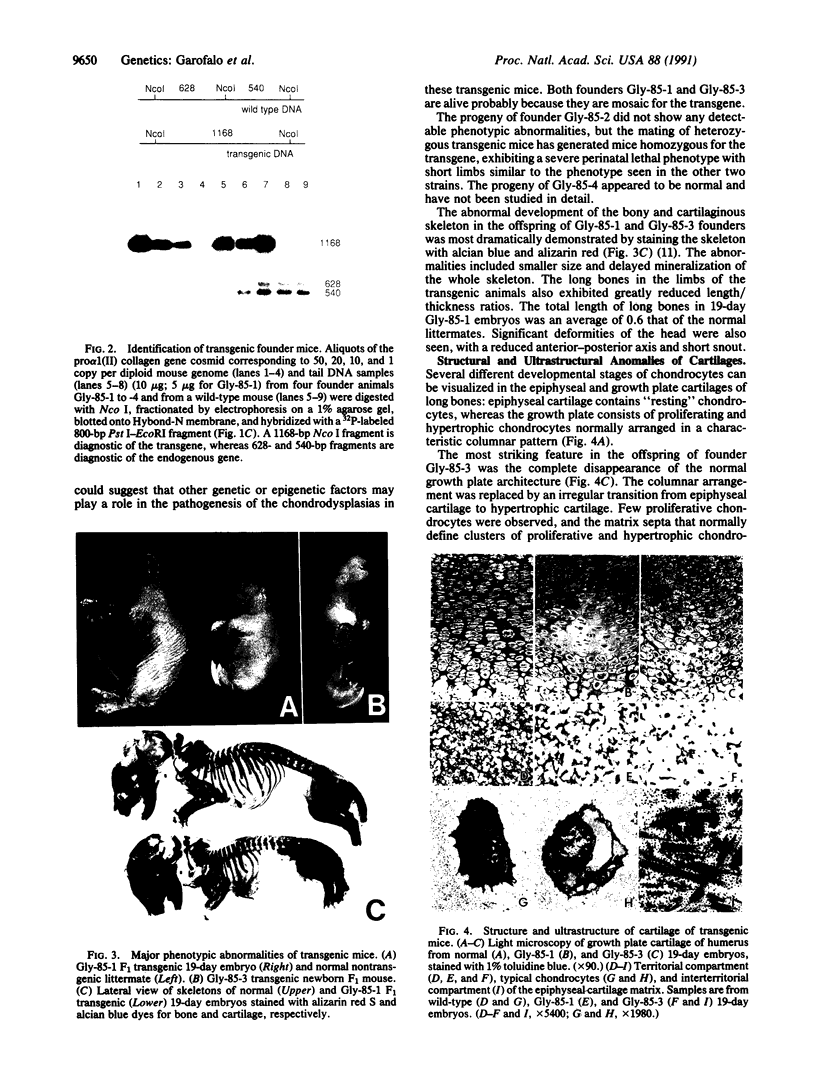
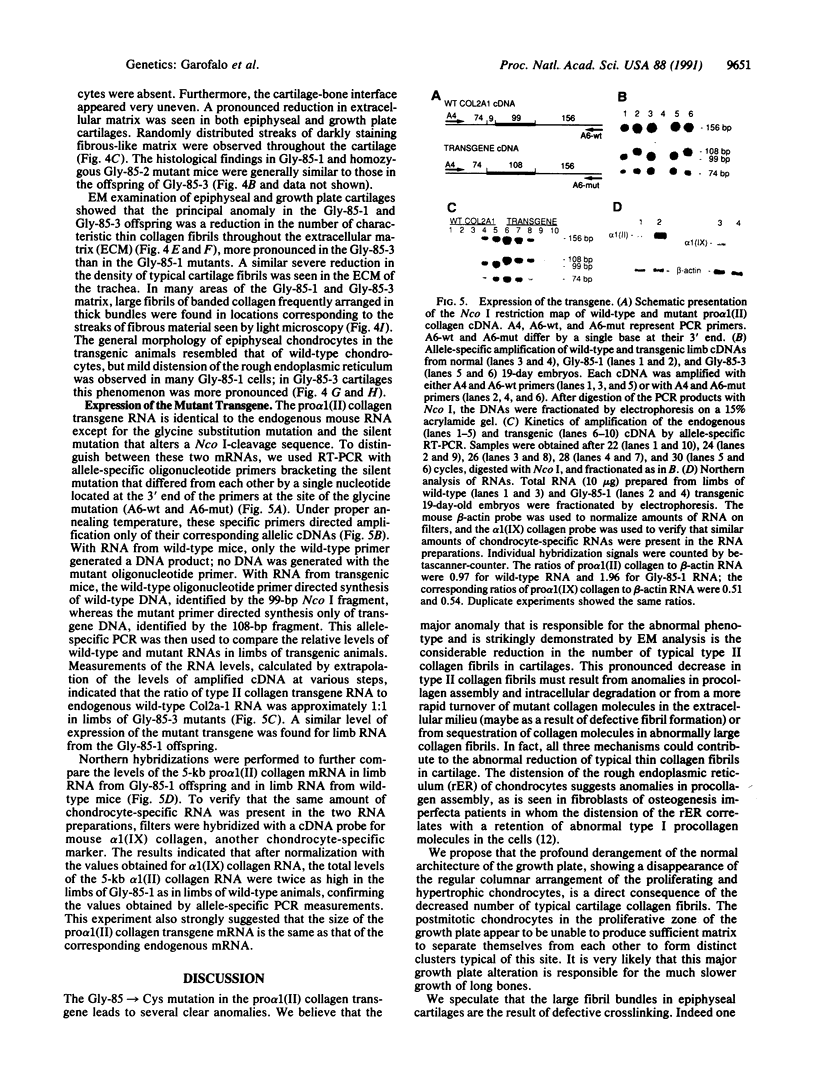
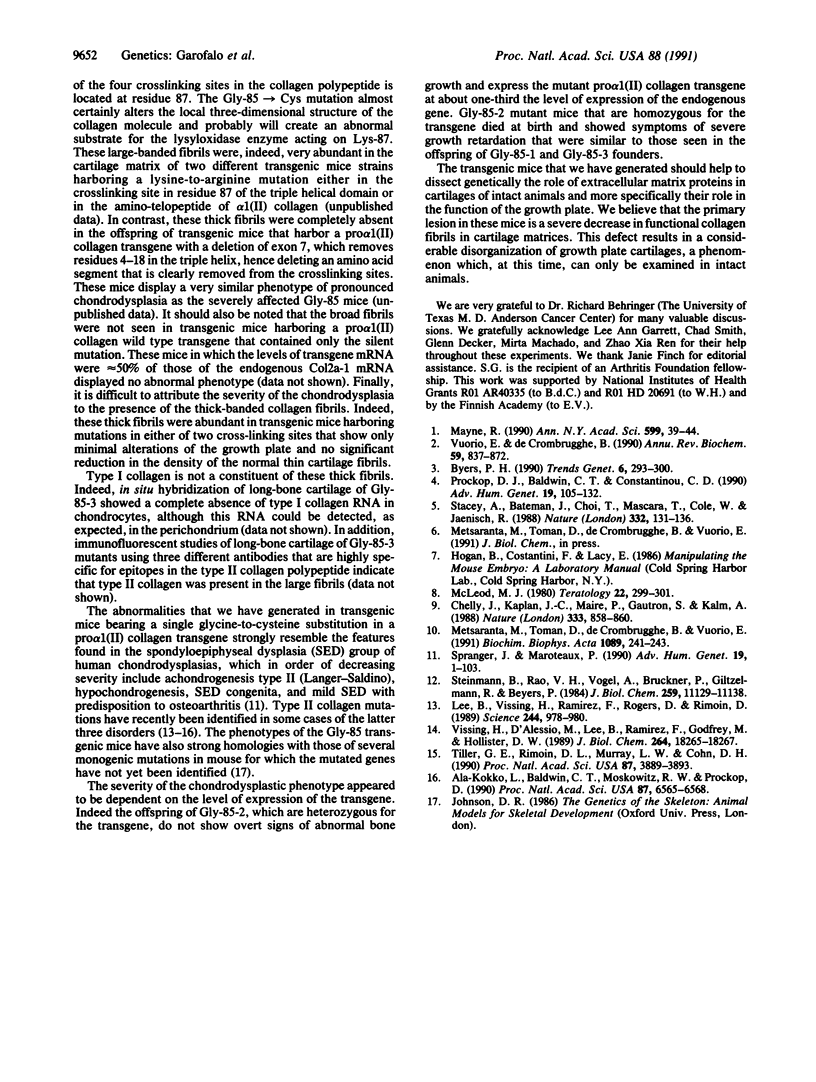
Images in this article
Selected References
These references are in PubMed. This may not be the complete list of references from this article.
- Ala-Kokko L., Baldwin C. T., Moskowitz R. W., Prockop D. J. Single base mutation in the type II procollagen gene (COL2A1) as a cause of primary osteoarthritis associated with a mild chondrodysplasia. Proc Natl Acad Sci U S A. 1990 Sep;87(17):6565–6568. doi: 10.1073/pnas.87.17.6565. [DOI] [PMC free article] [PubMed] [Google Scholar]
- Byers P. H. Brittle bones--fragile molecules: disorders of collagen gene structure and expression. Trends Genet. 1990 Sep;6(9):293–300. doi: 10.1016/0168-9525(90)90235-x. [DOI] [PubMed] [Google Scholar]
- Chelly J., Kaplan J. C., Maire P., Gautron S., Kahn A. Transcription of the dystrophin gene in human muscle and non-muscle tissue. Nature. 1988 Jun 30;333(6176):858–860. doi: 10.1038/333858a0. [DOI] [PubMed] [Google Scholar]
- Lee B., Vissing H., Ramirez F., Rogers D., Rimoin D. Identification of the molecular defect in a family with spondyloepiphyseal dysplasia. Science. 1989 May 26;244(4907):978–980. doi: 10.1126/science.2543071. [DOI] [PubMed] [Google Scholar]
- Mayne R. Collagen types and chondrogenesis. Ann N Y Acad Sci. 1990;599:39–44. doi: 10.1111/j.1749-6632.1990.tb42362.x. [DOI] [PubMed] [Google Scholar]
- McLeod M. J. Differential staining of cartilage and bone in whole mouse fetuses by alcian blue and alizarin red S. Teratology. 1980 Dec;22(3):299–301. doi: 10.1002/tera.1420220306. [DOI] [PubMed] [Google Scholar]
- Metsäranta M., Toman D., De Crombrugghe B., Vuorio E. Specific hybridization probes for mouse type I, II, III and IX collagen mRNAs. Biochim Biophys Acta. 1991 Jun 13;1089(2):241–243. doi: 10.1016/0167-4781(91)90014-d. [DOI] [PubMed] [Google Scholar]
- Prockop D. J., Baldwin C. T., Constantinou C. D. Mutations in type I procollagen genes that cause osteogenesis imperfecta. Adv Hum Genet. 1990;19:105–132. doi: 10.1007/978-1-4757-9065-8_2. [DOI] [PubMed] [Google Scholar]
- Spranger J., Maroteaux P. The lethal osteochondrodysplasias. Adv Hum Genet. 1990;19:1-103, 331-2. doi: 10.1007/978-1-4757-9065-8_1. [DOI] [PubMed] [Google Scholar]
- Stacey A., Bateman J., Choi T., Mascara T., Cole W., Jaenisch R. Perinatal lethal osteogenesis imperfecta in transgenic mice bearing an engineered mutant pro-alpha 1(I) collagen gene. Nature. 1988 Mar 10;332(6160):131–136. doi: 10.1038/332131a0. [DOI] [PubMed] [Google Scholar]
- Steinmann B., Rao V. H., Vogel A., Bruckner P., Gitzelmann R., Byers P. H. Cysteine in the triple-helical domain of one allelic product of the alpha 1(I) gene of type I collagen produces a lethal form of osteogenesis imperfecta. J Biol Chem. 1984 Sep 10;259(17):11129–11138. [PubMed] [Google Scholar]
- Tiller G. E., Rimoin D. L., Murray L. W., Cohn D. H. Tandem duplication within a type II collagen gene (COL2A1) exon in an individual with spondyloepiphyseal dysplasia. Proc Natl Acad Sci U S A. 1990 May;87(10):3889–3893. doi: 10.1073/pnas.87.10.3889. [DOI] [PMC free article] [PubMed] [Google Scholar]
- Vissing H., D'Alessio M., Lee B., Ramirez F., Godfrey M., Hollister D. W. Glycine to serine substitution in the triple helical domain of pro-alpha 1 (II) collagen results in a lethal perinatal form of short-limbed dwarfism. J Biol Chem. 1989 Nov 5;264(31):18265–18267. [PubMed] [Google Scholar]
- Vuorio E., de Crombrugghe B. The family of collagen genes. Annu Rev Biochem. 1990;59:837–872. doi: 10.1146/annurev.bi.59.070190.004201. [DOI] [PubMed] [Google Scholar]



